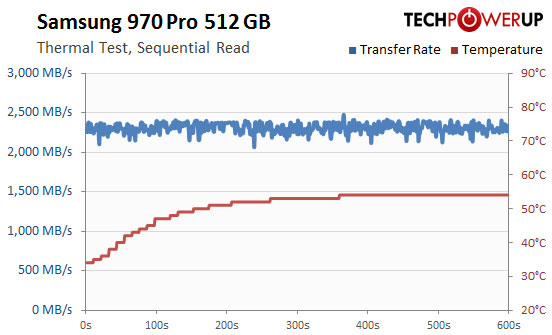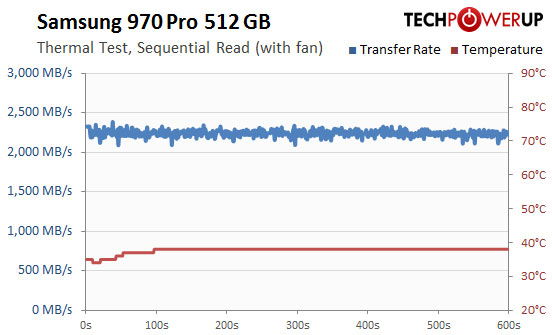 33
33
Samsung 970 Pro 512 GB Review
Windows 10 Startup & File Compression »Thermal Throttling
Due to the compact form factor, M.2 drives lack the ability to cool themselves and usually have to rely on passive airflow instead. As a safeguard, all vendors include some form of thermal throttling on their drives, which limits throughput once a certain temperature is exceeded.On this page, we will investigate whether the tested drive has such a mechanism, how high temperatures get, and what effect this has on performance. We will test the drive in a typical case, in the M.2 slot between the CPU and VGA card. A second data point shows the result when a 120 mm fan is blowing directly on the tested drive. Each of the charts has time moving from left to right, with the blue line displaying transfer speed in MB/s and the red line showing the temperature in °C (measured using SMART).
Reads


In a pure read scenario, the drive doesn't throttle at all.
Writes


Without a fan, the drive will start throttling once its internal temperature monitoring reports around 80°C. The throttling is fairly well-behaved, though, as it only drops from 2 GB/s to 1.5 GB/s and not all the way down to keep the drive's temperature in check. To put things into perspective, at 2 GB/s, for 150 seconds, the drive will only start thermal throttling after 300 GB of data have been written.
Thermal Image & Hot Spot

We recorded a thermal image of the running SSD as it was completing the write test. The hottest part reached 102°C, which is significantly higher than what the drive's own SMART temperature monitoring reports.
Jan 31st, 2025 01:52 EST
change timezone
Latest GPU Drivers
New Forum Posts
- Possible to use NVCleanstall but also use Nvidia App? (26)
- NVIDIA RTX owners only - your opinion on DLSS Image quality (432)
- Request to change nvenc repository (1)
- Will you buy a RTX 5090? (271)
- Testing max ram overclock pn Ryzen 1700 (33)
- Paper launch 5080/5090 - is this a problem for Nvidia? (9)
- Games run choppy with 9800x3d (3)
- Installing NVIDIA STUDIO DRIVER on unsupported GPU? (14)
- Gigabyte 5090 Aorus Master VRM Specs (11)
- So who’s paying $100 for GTA 6 then? (104)
Popular Reviews
- NVIDIA GeForce RTX 5080 Founders Edition Review
- NVIDIA DLSS 4 Transformer Review - Better Image Quality for Everyone
- Galax GeForce RTX 5080 1-Click OC Review
- ASUS GeForce RTX 5090 Astral OC Review - Astronomical Premium
- NVIDIA GeForce RTX 5090 Founders Edition Review - The New Flagship
- MSI GeForce RTX 5090 Suprim SOC Review
- MSI GeForce RTX 5090 Suprim Liquid SOC Review
- MSI GeForce RTX 5080 Vanguard SOC Review
- ASUS GeForce RTX 5080 Astral OC Review
- MSI GeForce RTX 5080 Suprim SOC Review
Controversial News Posts
- NVIDIA 2025 International CES Keynote: Liveblog (470)
- AMD Debuts Radeon RX 9070 XT and RX 9070 Powered by RDNA 4, and FSR 4 (349)
- AMD is Taking Time with Radeon RX 9000 to Optimize Software and FSR 4 (251)
- AMD Denies Radeon RX 9070 XT $899 USD Starting Price Point Rumors (227)
- AMD Radeon RX 9070 XT & RX 9070 Custom Models In Stock at European Stores (226)
- NVIDIA GeForce RTX 5090 Features 575 W TDP, RTX 5080 Carries 360 W TDP (217)
- New Leak Reveals NVIDIA RTX 5080 Is Slower Than RTX 4090 (214)
- AMD's Radeon RX 9070 Launch Faces Pricing Hurdles (175)